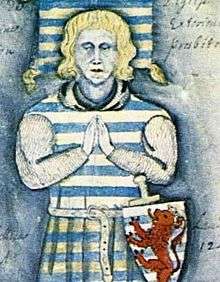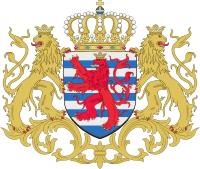Henry V, Count of Luxembourg
| Henry V | |
|---|---|
 | |
| Count of Arlon as Henry V | |
| Reign | 2 July 1226 – 24 December 1281 |
| Predecessor | Waleran III |
| Successor | Henry VI |
| Lord of Ligny as Henry I | |
| Reign | 1240 – 24 December 1281 |
| Predecessor | Henry II of Bar |
| Successor | Waleran I |
| Count of Luxembourg and Laroche as Henry V | |
| Reign | 12 February 1247 – 24 December 1281 |
| Predecessor | Ermesinda |
| Successor |
Henry VI (Luxembourg) Waleran I (Laroche) |
| Count of Namur as Henry III | |
| Reign | 1256–1264 |
| Predecessor | Baldwin II |
| Successor | Guy |
| Born | 1216 |
| Died |
24 December 1281 (aged 64–65) Mainz |
| Spouse | Margaret of Bar |
| Issue |
Henry VI, Count of Luxembourg Waleran I, Lord of Ligny Isabelle of Luxembourg Philippa of Luxembourg Margaret of Luxembourg Felicitas of Luxembourg Jeanne of Luxembourg |
| House | Luxembourg |
| Father | Waleran III of Limburg |
| Mother | Ermesinda of Luxembourg |
Henry V the Blondell (1216 – 24 December 1281), called the Great, was the count of Arlon from 1226 to his death, lord of Ligny from 1240 to his death, count of Luxembourg and Laroche from 1247 to his death, and the count of Namur between 1256 and 1264 as Henry III. He was the son and successor of Waleran III of Limburg and Ermesinda of Luxembourg.[1]
In 1226, following the death of his father Waleran III, Henry inherited the county of Arlon.
In 1240 Henry married Margaret of Bar,[1] daughter of Henry II of Bar and Philippa of Dreux who was the great-granddaughter of King Louis VI of France. Henry's marriage to Margaret brought him Ligny-en-Barrois as her dowry,[1] though, by a clause in the marriage contract, it remained under the feudal suzerainty of the county of Bar. In contempt of this, Henry paid homage in 1256 to Theobald II of Navarre, in his capacity as Count of Champagne. Henry's brother-in-law, Theobald II of Bar, took advantage of the conflict then raging between Frederick III of Lorraine and the bishops of Metz. Henry V was a partisan of the duke and so Theobald took the side of the bishop. Henry was captured in battle at Prény on 14 September 1266.[2] On 8 September 1268, King Louis IX arbitrated between the two counts and Henry was freed and repossessed of Ligny, but under the suzerainty of the Barrois.[3]
Henry inherited Luxembourg and Laroche following the death of his mother, Ermesinde, in 1247.[4]
In 1256, Henry seized Namur while the reigning margrave, Baldwin II, was also reigning emperor in Constantinople. Baldwin relinquished his rights to Namur to Guy of Dampierre, Count of Flanders, who retook the margraviate from Henry. The two parties made peace and Guy married Henry's daughter, Isabelle.
Upon receiving 15,000 tournois from the Pope, Henry joined Prince Edward of England on the Ninth Crusade.[5] He returned with his remaining retainers after the crusaders achieved a truce with the Mamluk Sultanate.[5]
Issue
From Margaret he had the following issue:
- Henry VI (died 1288), Count of Luxembourg[6]
- Waleran I (died 1288), Count of Ligny & Roussy
- Isabelle (1247–1298), married Guy of Dampierre[7][8]
- Philippa (1252–1311), married John II, Count of Holland
- Marguerite (lady of Macheren), living 1302
- Felicitas
- Jeanne (died 1310), Abbess at Clairefontaine Abbey of Clairefontaine
He also had at least two illegitimate sons,[6] including:
- Henry, bastard of Luxembourg (died 1288),[6] married Isabelle of Houffalize, heiress of Houffalize
- Baldwin[6]
Notes
References
- Arblaster, Paul (2012). A History of the Low Countries. Palgrave Macmillan.
- Gade, John A. (1951). Luxemburg in the Middle Ages. E.J. Brill.
- Jackson-Laufer, Guida Myrl (1999). Women Rulers Throughout the Ages: An Illustrated Guide. ABC-CLIO.
- Verbruggen, J. F. (2002). DeVries, Kelly, ed. The Battle of the Golden Spurs (Courtrai, 11 July 1302). Translated by Ferguson, David Richard. Boydell Press.
| Wikimedia Commons has media related to Henry V, Count of Luxembourg. |
Henry V, Count of Luxembourg Born: 1216 Died: 24 December 1281 | ||
| Preceded by Ermesinde |
Count of Laroche 1247–1281 |
Succeeded by Waleran I |
| Count of Luxembourg 1247–1281 |
Succeeded by Henry VI | |
| Preceded by Waleran III |
Count of Arlon 1226–1281 | |
| Preceded by Baldwin II |
Count of Namur 1256–1264 |
Succeeded by Guy |


